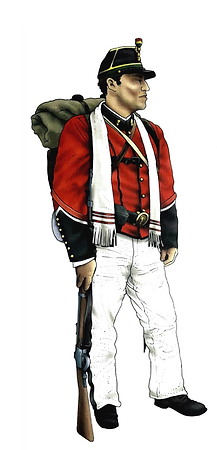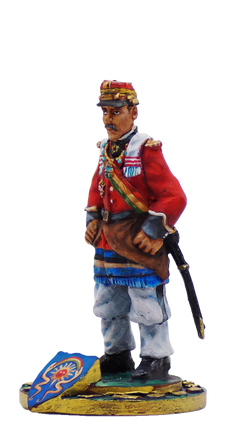
Lizandro Obando Camero
Auqui Mayorazgo of House of Incas
Don Lizandro Obando Camero was Peruvian army officer. At the beginning of the twentieth century he was the Auqui Mayorazgo of the House of the Incas. For being the direct descendant through the male or patrilineal line of the last Inca sapam or Inca emperor Huayna Capac. In other words, the eldest male son of the eldest male son of fourteen generations of the family directly descended from the aforementioned last Inca sapam of the Tahuantinsuyo, whose seat is the historic centre of the city of Cusco. Obando family is strictly from the city of Cusco, according to genealogical studies by the Dutch historian Ronald Elward, ‘is the name used by the heirs of this important branch of the Imperial Inca family’ to hide from the persecution, expropriation and mistreatment of the chaotic and corrupt Peruvian republican era. In the past, his family home was located in the Santo Domingo square in front of the temple to the Sun, the Koricancha, nowadays the Libertador hotel. Likewise, the ancestors of Don Lizandro during the colonial period held the positions of quasiques of Choco, Cachona, Santa Ana and Quispicanchis until the arrival of independence. According to the genealogical research of the aforementioned scholar Ronald Elward, it should be noted that the surname OBANDO is actually the surname adopted by the illustrious descendants of the Inca

emperor Pachacutec of the San Blas district, who married 70 years before independence, with the powerful Cusquenian casical family Ramos-Titu-Atauchi-Inca (descendants of the Inca Huayna Capac), This family was called the Obando-Titu Atauchi Inca family until the end of the colonial period, to which also belonged the late Cusco intellectual patrician Luis Felipe Paredes Obando, who at the same time was linked to the Betancourt Tupac Amaru family. It is worth mentioning that Don Lizandro is the heir to the ‘Mayorazgo’ or principal heir to the rights of honour granted by the system of Hispanic Roman Law, by which the Peruvian State is governed, as the aforementioned ‘Mayorazgo’ is a legal institution of the Western world. On the other hand, the title of Sapan Inca is reserved for the most outstanding of the lineage of the Inca Huayna Capac, a contest that does not take place almost 500 years ago, nor does it have a close date.

The Bolivian Army (Spanish: Ejército Boliviano) is the land force branch of the Armed Forces of Bolivia. The Bolivian Army usually began its history in the fields of Aroma with the victory of the Cochabamba militias over the royalist troops under the command of General Esteban Arze, but institutionally it was created together with the Declaration of Independence of Bolivia, as an independent Republic on 6 August 1825, by the General Assembly of Deputies of the Provinces of Upper Peru, under the name of the Republic of Bolivar (later changed to the Republic of Bolivia) Ronald Blanco. In 1826 the Liberator Simón Bolívar granted the country its first constitution, which was approved by the Congress of Chuquisaca. It structured the army. Antonio José de Sucre, Grand Marshal of Ayacucho, was elected his successor as President of the Republic. Since its emancipation, Bolivia was plunged into a chronic state of revolutions and civil wars. In 1866 and 1874, two treaties were signed to settle the dispute with Chile over the Atacama Desert, rich in sodium nitrate and copper deposits. These treaties adopted the 24th parallel south latitude as the boundary line (between Chile and Bolivia). Chile was granted various customs duties and mining concessions to Chilean entrepreneurs in the Bolivian Atacama. These latter provisions gave rise to litigation between the two countries, as the Bolivian state did not respect the tariff agreements, increasing the tax on nitrate extraction for the Chilean-British saltpetre companies, and in February 1879, Chile occupied the former Bolivian port of Antofagasta, starting the so-called War of the Pacific in which
Bolivia and its ally Peru were defeated by Chile. At the end of the war, Bolivia was deprived of its only coastal possession and was no longer landlocked. The Bolivian littoral covered some 158,000 km² and, in addition to Antofagasta, included the major ports of Mejillones, Cobija and Tocopilla. The 1904 Treaty recognised Chile's control of the disputed territory in perpetuity, although it guaranteed Bolivia free access to the sea. Bolivia also fought a war with the Brazilian Seringueiros over the Acre territory, or (at the time) Territorio de Colonias, in the so-called Acre War, which ended with the Treaty of Petrópolis, which saw Bolivia cede 191,000 km² to Brazil in exchange for economic indemnity and a small territorial compensation, as well as the recognition (by Brazil) that Bolivia was the legitimate owner of the whole of the Chaco Boreal. Bolivian Colorados is the 39th Line Infantry Battalion "Colorados" is one of the Army's oldest and most prestigious infantry regiments. Established in 1821, this regiment is mostly a ceremonial unit, being the escort security regiment of the President of Bolivia. This is the Bolivian Army's most represented unit, having a close connection with the Bolivian people, whatever their race, and has a contribution to national history. During the War of the Pacific, Bolivia alongside Peru, fought for their respective nations' mining interests against the Chilean forces. Bolivia's contributions to the war included 2 cavalry squadrons, an artillery battery, and three infantry battalions, all equipped with fusils and rifles, among them being the Bolivian Colorados. They formed the Bolivian Army under President Daza's leadership as Commander in Chief. As part of the combined Bolivian-Peruvian Allied Army, the Bolivian Colorados contributed their hard work to bring victory to the combined armies, at the cost of many lives. The Colorados were in action in some of the great battles of the war, including the Battle of San Francisco (also known as Battle of Dolores) where the Camarones betrayal happened, and the Battle of Tacna, where it was listed and then renamed as the 1st Alliance Infantry Battalion, now part of the forces under the new army chief President Narciso Campero. Most of the time however, before the fighting in Tacna, it was always on the reserve, due to the belated formations of infantry battalions. May 26 is Infantry Day in Bolivia in recognition of the Colorados' bravery throughout the whole battle of Tacna, led by regimental commander Colonel Ildefonso Murguia Anze and regimental drummer Juan Pinto. This battle was where the Colorados shouted their battle cry: Temblad rotos, que aqui entran los Colorados de Bolivia! (Rotos, be shaken, because the Colorados of Bolivia have come!) and formed a gallant defense alongside their Peruvian allies. Every year (except in 2009) the Colorados come back to the place of their glorious exploits to commemorate the Bolivians' gallantry and courage seen in this battle. As part of the National Army of Bolivia in 1903 (led by the President of Bolivia Jose Manuel Pando), it fought in the Acre War for Bolivian control of that region.

The Inca royal house, also known as Ayllu Real or Inca Imperial Family, of the Sapa Inca emperors Huayna Capac and Tupac Yupanqui. It is necessary to clarify that the name panaka was given to the families of the ancient Inca priest-kings, belonging to the Hurin Cusco dynasty, while the name Ayllu Real corresponds to the Hanan Cusco dynasty, according to the researcher Donato Amado. Consequently, the highest rank of the Inca nobility belonged to the royal aillu of the Inca Huayna Capac, whose house was the last to rule until and during the Hispanic conquest. After a few years and after the first cultural-military clash with the Castilians, after their defeat it was respected by the Spanish Crown, and preserved in the city of Cusco, under a legal regime of exception, due to the symbolic nature of its representation. However, in the Peruvian Republican era, they suffered the usurpation of their property, invalidation of their titles, and other reforms that diminished their political power and annihilated their economic fortune. The descendants of their entailed estate or core branch can be traced to the present day in the city of Cuzco, the ancient capital of the Inca empire, known as Tahuantinsuyo or ‘Empire of the Four Regions’. Descent of Paullu Inca are The group of descendants of Cristóbal Paullu Inca, son of the emperor Huayna Cápac, of whom one of his branches
currently holds the majorat or direct patrilineal descent. Both through their legitimate descendants and through their children legitimised by Emperor Charles V. Obando Tito Atauchi family are the descendants of Quispe Topa Inka, who assumed the colonial name of Bartolomé Topa Atao or Quispe Tito Atauchi, who during the 18th century adopted the surname Ramos Tito Atauchi and in the 19th century, that of Obando or Obando Titu Atauchi. According to the historian John Hemming, this branch of the Inca royal family is the result of the union of the descendants of two very important Inca Houses or two princely sons of the emperor Huayna Capac: Paullo Inca and Titu Atauchi Inca. However, the study of the genealogist Ronald Elward, refers that they are rather descendants of the Chancellor Titu Atauchi another Inca prince brother of the emperor Huayna Capac Inca, whose daughter or granddaughter had a son with the prince Paullo Inca, who was legitimised by the emperor Carlos V, called Bartolomé Titu Atauchi.
Awards: Star and insignia of the Grand National Order of the ‘Legion of Honour’ Republic of Bolivia.






